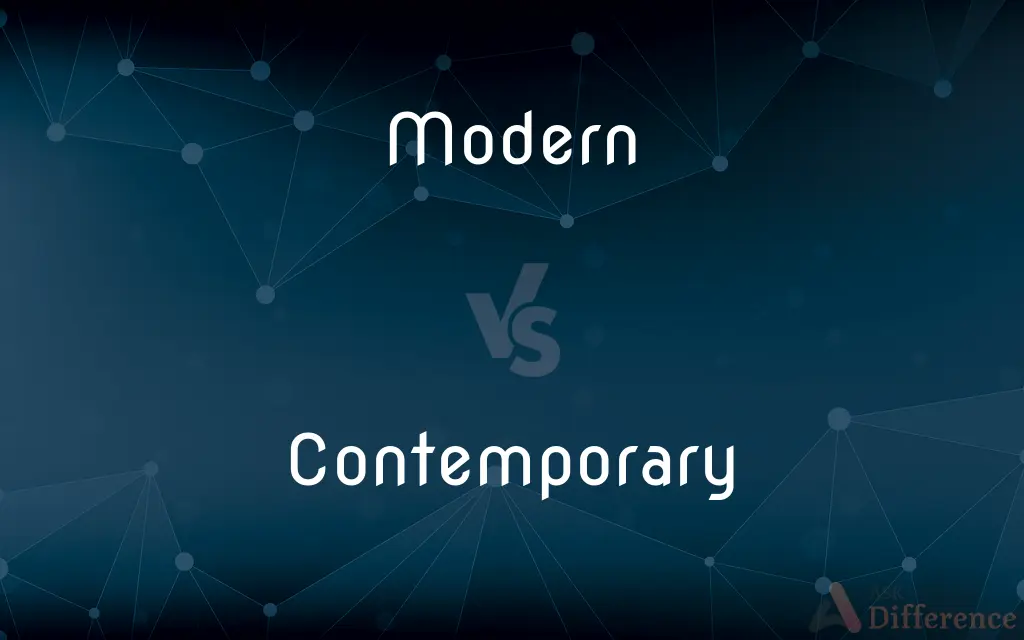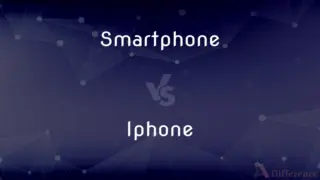Modern vs. Contemporary — What's the Difference?
Edited by Tayyaba Rehman — By Maham Liaqat — Updated on March 13, 2024
Modern design refers to the architectural and interior style of the mid-20th century, characterized by clean lines and minimalism, while contemporary design represents the style of the present, constantly evolving with current trends and technologies.

Difference Between Modern and Contemporary
Table of Contents
ADVERTISEMENT
Key Differences
Modern design emerged in the early to mid-20th century, focusing on simplicity, functionality, and the use of industrial materials. It champions a streamlined approach with minimal ornamentation. On the other hand, contemporary design is dynamic, reflecting styles and trends that are current and evolving. It can incorporate elements from various time periods, making it more eclectic.
While modern design often incorporates a specific range of materials like steel, glass, and concrete, emphasizing their functional aspects and aesthetic simplicity, contemporary design is more flexible, utilizing a wide variety of materials that suit current tastes and technological advancements. This flexibility allows contemporary design to blend and adapt more freely than its modern counterpart.
Modern design's color palette tends to stay neutral, with blacks, whites, and grays dominating the space to create a clean and uncluttered look. Conversely, contemporary design does not shy away from bold and vibrant colors, using them to add character and dynamism to spaces, reflecting current color trends and personal preferences.
Furniture in modern design is characterized by its clean lines, organic curves, and a nod to industrial aesthetics, often resulting in pieces that are both functional and sculptural. Contemporary design furniture, while it may borrow from the modernist ethos, often experiments with shapes, materials, and colors, resulting in a more diverse range of aesthetics.
In terms of philosophy, modern design was born out of the desire to break away from the ornate styles of the past, emphasizing the idea of "form follows function." Contemporary design, while valuing functionality, places a stronger emphasis on individuality and the reflection of the current societal and technological state, making it more about "form reflects time."
ADVERTISEMENT
Comparison Chart
Time Period
Early to mid-20th century
Current, 21st century
Design Principles
Minimalism, functionality, clean lines
Evolving, eclectic, embracing of current trends
Material Use
Industrial materials (steel, glass, concrete)
Diverse, incorporating new and traditional materials
Color Palette
Neutral colors (black, white, gray)
Bold and vibrant colors, alongside neutrals
Furniture Style
Functional, sculptural, with clean lines and organic curves
Diverse, experimental with shapes and materials
Compare with Definitions
Modern
Focuses on simplicity and functionality.
A modern kitchen typically features streamlined cabinets and stainless steel appliances.
Contemporary
Reflects current styles and trends.
The contemporary hotel lobby features artwork and furniture from the latest designers.
Modern
Characterized by its historical time period.
Mid-century modern furniture is highly sought after for its timeless appeal.
Contemporary
Uses a wide range of materials.
Contemporary architecture often experiments with sustainable materials alongside traditional ones.
Modern
Utilizes industrial materials like steel and concrete.
Modern architecture often incorporates large glass windows and steel frames.
Contemporary
Adapts and evolves with time.
Contemporary home decor can easily incorporate both traditional and modern elements.
Modern
Emphasizes clean lines and minimal ornamentation.
The modern living room boasts a simple color scheme and uncluttered layout.
Contemporary
Often includes bold color choices.
A contemporary living room might feature a vibrant accent wall.
Modern
Features a neutral color palette.
The modern office design uses shades of gray and white to enhance its minimalist aesthetic.
Contemporary
Is eclectic and diverse in its aesthetics.
Contemporary interior design blends textures and patterns to create a unique space.
Modern
Of or relating to recent times or the present
Modern history.
Contemporary
Occurring in the same period of time;
A rise in interest rates is often contemporaneous with an increase in inflation
The composer Salieri was contemporary with Mozart
Modern
Characteristic or expressive of recent times or the present; contemporary or up-to-date
A modern lifestyle.
A modern way of thinking.
Contemporary
Living or occurring at the same time
The event was recorded by a contemporary historian
Modern
Of or relating to a recently developed or advanced style, technique, or technology
Modern art.
Modern medicine.
Contemporary
Belonging to or occurring in the present
The tension and complexities of our contemporary society
Modern
Avant-garde; experimental.
Contemporary
A person or thing living or existing at the same time as another
He was a contemporary of Darwin
Modern
Often Modern(Linguistics) Of, relating to, or being a living language or group of languages
Modern Italian.
Modern Romance languages.
Contemporary
Belonging to the same period of time
A fact documented by two contemporary sources.
Modern
One who lives in modern times.
Contemporary
Of about the same age.
Modern
One who has modern ideas, standards, or beliefs.
Contemporary
Current; modern
Contemporary trends in design.
Modern
(Printing) Any of a variety of typefaces characterized by strongly contrasted heavy and thin parts.
Contemporary
One of the same time or age
Shelley and Keats were contemporaries.
Modern
Pertaining to a current or recent time and style; not ancient.
Our online interactive game is a modern approach to teaching about gum disease.
Although it was built in the 1600s, the building still has a very modern look.
Contemporary
A person of the present age.
Modern
(history) Pertaining to the modern period (c.1800 to contemporary times), particularly in academic historiography.
Contemporary
From the same time period, coexistent in time; contemporaneous.
Modern
Someone who lives in modern times.
Contemporary
Modern, of the present age (shorthand for ‘contemporary with the present’).
Modern
Of or pertaining to the present time, or time not long past; late; not ancient or remote in past time; of recent period; as, modern days, ages, or time; modern authors; modern fashions; modern taste; modern practice.
Contemporary
Someone or something living at the same time, or of roughly the same age as another.
Cervantes was a contemporary of Shakespeare.
The early mammals inherited the earth by surviving their saurian contemporaries.
Modern
New and common; trite; commonplace.
We have our philosophical persons, to make modern and familiar, things supernatural and causeless.
Contemporary
Something existing at the same time.
Modern
A person of modern times; - opposed to ancient.
Contemporary
(dated) A rival newspaper or magazine.
Modern
A contemporary person
Contemporary
Living, occuring, or existing, at the same time; done in, or belonging to, the same times; contemporaneous.
This king [Henry VIII.] was contemporary with the greatest monarchs of Europe.
Modern
A typeface (based on an 18th century design by Gianbattista Bodoni) distinguished by regular shape and hairline serifs and heavy downstrokes
Contemporary
Of the same age; coeval.
A grove born with himself he sees,And loves his old contemporary trees.
Modern
Belonging to the modern era; since the Middle Ages;
Modern art
Modern furniture
Modern history
Totem poles are modern rather than prehistoric
Contemporary
One who lives at the same time with another; as, Petrarch and Chaucer were contemporaries.
Modern
Relating to a recently developed fashion or style;
Their offices are in a modern skyscraper
Tables in modernistic designs
Contemporary
A person of nearly the same age as another.
Modern
Characteristic of present-day art and music and literature and architecture
Contemporary
A person of nearly the same age as another
Modern
Ahead of the times;
The advanced teaching methods
Had advanced views on the subject
A forward-looking corporation
Is British industry innovative enough?
Contemporary
Characteristic of the present;
Contemporary trends in design
The role of computers in modern-day medicine
Modern
Used of a living language; being the current stage in its development;
Modern English
New Hebrew is Israeli Hebrew
Contemporary
Belonging to the present time;
Contemporary leaders
Common Curiosities
What defines modern design?
Modern design is characterized by its emphasis on simplicity, functionality, and the use of industrial materials, stemming from the early to mid-20th century.
What materials are commonly used in modern design?
Steel, glass, and concrete are hallmark materials of modern design, reflecting its industrial influences.
What color schemes are typical of contemporary design?
Contemporary design is known for both its use of bold and vibrant colors and its incorporation of neutrals, depending on the current trends and personal preferences.
How does contemporary design differ from modern design?
Contemporary design is dynamic, reflecting current styles and trends, and is more eclectic and flexible in its approach compared to the minimalist and period-specific modern design.
Can modern and contemporary designs be mixed?
Yes, it's possible to mix modern and contemporary elements in a space, often resulting in a layered and interesting aesthetic.
How do contemporary designers approach the use of technology?
Contemporary design often incorporates the latest technological advancements to enhance functionality and aesthetic appeal.
How do lighting choices differ between modern and contemporary designs?
Modern design favors simple, often geometric lighting fixtures, while contemporary design might include a variety of lighting styles, reflecting current trends.
How does the philosophy of "form follows function" apply to modern design?
This philosophy underpins modern design, prioritizing the functionality of a space or object over ornamental aspects.
What is the significance of color in modern design?
Color, often neutral, plays a crucial role in modern design to create a sense of calm, simplicity, and cohesion in a space.
Can traditional elements be part of contemporary design?
Yes, contemporary design can incorporate traditional elements, blending them with modern ideas to create unique and personal spaces.
Are natural materials used in contemporary design?
Yes, contemporary design embraces a wide range of materials, including natural ones, to suit aesthetic preferences and sustainability goals.
How does contemporary design reflect current societal states?
Contemporary design mirrors the current societal and technological advancements, incorporating elements that reflect the times' preferences, values, and innovations.
Is contemporary design the same as being trendy?
While contemporary design reflects current trends, it encompasses a broader approach to interior and architectural design that may include timeless elements.
Is minimalism exclusive to modern design?
While minimalism is a core principle of modern design, contemporary design also employs minimalism, though it may be balanced with eclectic and bold elements.
What makes furniture design modern?
Modern furniture design is known for its streamlined, functional, and often sculptural qualities, emphasizing clean lines and organic forms.
Share Your Discovery

Previous Comparison
Smartphone vs. iPhone
Next Comparison
Bau vs. GauAuthor Spotlight
Written by
Maham LiaqatEdited by
Tayyaba RehmanTayyaba Rehman is a distinguished writer, currently serving as a primary contributor to askdifference.com. As a researcher in semantics and etymology, Tayyaba's passion for the complexity of languages and their distinctions has found a perfect home on the platform. Tayyaba delves into the intricacies of language, distinguishing between commonly confused words and phrases, thereby providing clarity for readers worldwide.















































